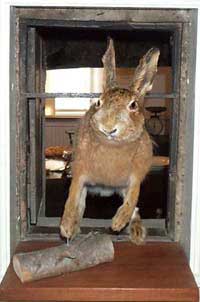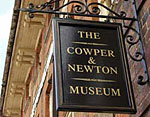|
The Cowper and Newton Museum
|
|
Virtual Tour: the Hall
|
 |
When Cowper and Mrs. Unwin lived at Orchard Side, the Hall door was seldom opened. The room was used to house pets, including the hares, Puss, Tiny and Bess.
Apart from containing various hutches, the Hall was the repository of Cowper's carpentry.
|
|
|
Garden implements too were kept in the Hall which was not set out to impress visitors who were obliged to enter the house through the kitchen, especially after one of the hares escaped through the hall door.
In a letter to his cousin. Lady Hesketh, of 9th February 1786, Cowper describes the Hall and its contents.
If you cast a look on either side of you, you shall see ...a box of my own making ...in which have been lodged all my hares. On the right hand stands a cupboard, the work of the same author; it was once a dove-cage but I transformed it.....Opposite to you stands a table which I also made but a merciless servant having scrubbed it, until it became paralytic, it serves no purpose now but of ornament.
|
 |
Corner of Hall with the window facing onto Market Place |
|
Portrait of Cowper's Father
Oil on Canvas, Artist unknown.
Revd. John Cowper was Rector of Berkhamsted and father of William Cowper. He came from a Hertfordshire family and was son of Judge Spencer Cowper.
In 1728 he married Ann Donne and was an undemonstrative parent of his surviving children, William and John.
Following Ann's death in 1737, he married Rebecca Marryat in 1741.
John Cowper died in 1756.
|
 |
|
 |
Portrait of Cowper's Mother
Oil on Canvas W.S. Wright 1909
Ann Cowper (née Donne) of Bedlam Grange, Norfolk.The Donnes claimed descent from Henry III.
Ann was a sensitive and affectionate parent to her sons, William and John, and she was remembered by Cowper in an idealised way.
|
|
|
She died when he was six years old and her death was the strongest of Cowper's childhood memories.
I heard the bell toll'd on thy burial day
I saw the hearse that bore thee slow away.
From the poem 'On Receipt of my mother's Picture' 1790
|
Portrait said to be Cowper aged 32
Colour engraving by John Chapman. After Pastel Drawing by John Russell (1745-1806)
Russell was a pastel painter who studied at the Royal Academy, becoming RA in 1788. He was a portrait painter to George III.
The features of this portrait have much in common with a bust of Cowper produced in Egyptian basaltware by Wedgwood c.1909. The bust was reviewed in the Connoisseur, January 1909.
|
 |
|
 |
Entrance to Hall from Kitchen
The bookshelves contain National Gallery portraits of Cowper's literary contemporaries. The glass cabinet contains various sporting trophies associated with Cowper's relatives. Attached to the wall is a letter stating how Cowper's name should be pronounced (see below). Below the coat-of arms is a time-line for the period of Cowper's life.
|
|
 |
Entrance to Parlour from Hall
The glass cabinet contains various objects owned and associated with Cowper. Some of them are shown and illustrated below. The oil painting is a temporary hanging of a view of Olney Church from the river. The other three sketches are decribed below. Cowper's Family Tree is above the cabinet.
|
|
Some of the items in the display cabinet |
 |
Watchstand
said to be made from the wood of a mulberry tree which grew in Cowper's garden.
|
Watch
belonging to Cowper, which on his death came into the possession of his cousin Johnny Johnson.
|
 |
| Brooch
set with 10 amethysts and containing a lock of Cowper's hair.
|
 |
| Cowper's Silver Stock Buckle |
 |
 |
Pair of buckles
and pair of straps for knee breeches belonging to Cowper and used "for at least twelvemonth before he died".
|
Snuff box
with painting of three hares on lid by Romney. Gift to Cowper from his cousinTheodora.
|
 |
| Handkerchiefs
owned by Cowper (1800).
|
 |
|
Other items on display in the Hall |
 |
Berkhamsted Rectory
Birthplace of Cowper.
|
|
| The Collegium Insanorum
Sketch of Dr Cotton's House and Asylum in St Albans where Cowper resided from 1763 - 1765.
|
 |
|
 |
Huntingdon
much as Cowper would have known it, when he lodged there with the Unwins. The drawing shows the Church in which the Rev. Morley Unwin was buried following his accidental death in 1767.
|
|
The Cowper Arms
The Cowper arms described heraldically are:
- First and fourth argent: three martlets gules; on a chef engraled of the last, as many anulets or for Cowper.
- Second and third: or, on a chevron sable, three escallops argent; on a chef of the second, a lion passant of the third, for Stanbridge.
- Crest a lion's gambe erect and erased, or; holding a branch vert, fruited gules.
Tuum Est was used by Classical Roman writers meaning: It is thy Duty.
|
 |
|
 |
The "Port-Hole"
This so called 'Port Hole' was named by the Scottish geologist and writer Hugh Miller when he visited Orchard Side in 1846.
There is a small port-hole... Cowper's hares used to come leaping for their evening gambles.
Edinburgh 1874.
It is likely the opening was a window taking borrowed light from the hall to the kitchen fireplace.
The myth has been perpetuated by the Museum's acquisition of this stuffed hare. When not in the garden or parlour, Cowper's hares were kept in hutches in the hall.
|
|
How did Cowper pronounce his name?
On display in the Hall is a letter from Charles Longuett-Higgins, son of Cowper's friend, which settles this question quite conclusively:
I can with certainty inform you that the Poet himself, and all his immediate relatives and friends, used to pronounce his name as if it was spelt Cooper - that is without the w.
My dear Father and grandfather, who were among his most intimate friends, the whole time of his living at Weston Underwood and Olney, knew well this to have been the case. I have myself heard my father say so very many times.
|
You are in the Hall
Click on the hare to continue the guided tour

or use the floorplan to move to another room
|
|
|
|
|
|
